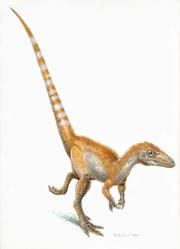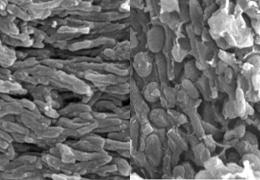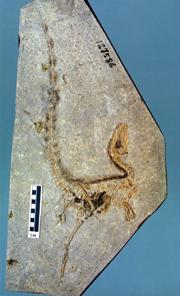NaturNews: Fossil feathers reveal dinosaurs' true colours
Matt Kaplan

Pristine fossils of dinosaur feathers from China have yielded the first clues about their colour.
A team of palaeontologists led by Michael Benton of the University of Bristol, UK, and Zhonghe Zhou of the Institute of Vertebrate Paleontology and Paleoanthropology in Beijing, has discovered ancient colour-producing sacs in fossilized feathers from the Jehol site in northeastern China that are more than 100 million years old.
These pigment-packed organelles, called melanosomes, have only been found in fossilized bird feathers before now.
The team discovered the melanosomes in fossils of the suborder Theropoda, the branch of the dinosaur family tree to which the flesh-eating species Velociraptor and Tyrannosaurus belong. However, it was not in these two iconic dinosaurs that the organelles were found, but in smaller species that ran around low to the ground with tiny feathers or bristles distributed across their bodies.
The team discovered two types of melanosome buried within the structure of the fossil feathers: sausage-shaped organelles called eumelanosomes that are seen today in the black stripes of zebras and the black masks of cardinal birds, and spherical organelles called phaeomelanosomes, which make and store the pigment that creates the rusty reds of red-tailed hawks and red human hair.
The team didn't find cell structures or machinery responsible for other colours, such as yellows, purples and blues. They suggest that dinosaur cells might have produced coloured pigments such as carotenoids and porphyrins, but that the proteins that make them degrade more rapidly than organelles, so do not leave a trace in fossils. Melanosomes, by contrast, are an integral part of a feather's tough protein structure so can survive for longer.

"We always tell introductory palaeontology students that things like sound and colour are never going to be detected in the fossil record," says Benton. "Obviously that message needs to be reconsidered."
Fossils of one theropod dinosaur, Sinosauropteryx, reveal that it had light and dark feathered stripes along the length of its tail. The team found that feathers from the darker regions of the tail were packed with phaeomelanosomes, indicating they were russet-orange in colour. The lighter stripes could have been white, says Benton, but because some pigments degrade and don't leave a fossil signature, it is difficult to be sure.
Sinosauropteryx was not the only colourful feathered species. Another small theropod species, Sinornithosaurus, had feathery filaments that were dominated by either eumelanosomes or phaeomelanosomes, hinting that its individual feathers varied in colour between black and russet-orange.
A lot of questions have been raised about the structures that are found on the earliest of the feathered dinosaurs, such as Sinosauropteryx. Some palaeontologists argue that these bristle-like structures are actually fossilized connective tissue rather than early feathers.
However, says Benton, in modern birds — which evolved from the theropod dinosaurs — melanosomes are found only in the developing feathers and not in the connective tissue. The fact that the melanosomes in the dinosaur feathers are also found inside the bristles themselves resolves the debate, he says.

"This paper puts the nails in the coffin of arguments countering the feather nature of these structures," agrees Luis Chiappe, a palaeontologist at the Natural History Museum of Los Angeles County, California.
"It is deeply gratifying that this colour discovery is allowing us to finally agree that the structures on Sinosauropteryx were actually early feathers," says evolutionary ornithologist Richard Prum of Yale University in New Haven, Connecticut. "Now we can get on with studying their evolution."
In addition, the discovery of colour in the earliest feathers may also sway the biggest dinosaur debate of them all — what the feathers were actually being used for.
The tiny bristles on early feather-bearers could not have been used for flight, as some have suggested, because they would have provided no lift. But they could have served as insulation, or for display.
"It is looking increasingly likely to me that these dinosaurs were making a visual statement," says Benton. "What that statement was, we don't know, but you don't have a orange-and-white striped tail for nothing."
Download attachments: